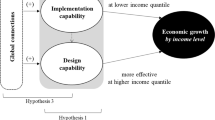Abstract
As with all policy-oriented concepts, there is a risk of tailoring the definition of indigenous capability (ITC) to a conclusion: since ITC is obviously desirable, one is inclined to find in it an omnibus quality which brings all the luck in acquiring and using technology. Whether such a talisman exists or not, it is necessary to specify what precisely is required; and a closer familiarity with how technology actually changes in less-developed countries is necessary to understand how far the acquisition of ITC is feasible. In this paper we seek to set out what we understand by ITC, and to place it in the context of technological changes in Indian industry to get some idea of its feasibility and phasing.
Access this chapter
Tax calculation will be finalised at checkout
Purchases are for personal use only
Preview
Unable to display preview. Download preview PDF.
Similar content being viewed by others
References
Chaudhury, Shekhar (1980) ‘Acquisition and Assimilation of Technology in the Tractor Industry in India: the Strategic Perspective’, Ph.D. thesis, Indian Institute of Management, Ahmedabad.
Desai, Padma (1972) The Bokaro Steel Plant. A Study of Soviet Economic Assistance. Amsterdam: North Holland.
Desai, Ashok V. (1960) ‘Factors Underlying the Slow Growth of Indian Industry’, Economic and Political Weekly, Annual Number 16 (10–12) 381–92.
Federation of Indian Chambers of Commerce and Industry (1980) Report of Workshop on Indian Joint Ventures Turnkey and Third Country Projects. 13 March 1980, New Delhi.
Indian Chemical Manufacturers’ Association (1970) Preliminary Survey on the Status of Research and Development in Chemical Industry. Bombay.
Indian Chemical Manufacturers’ Association (1971) Proceedings of the Symposium on Import Substitution in the Chemical and Fertilizer Industry. Bombay.
Indian Chemical Manufacturers’ Association (1976) Proceedings of the Seminar on the High Cost of Manufacturing Chemicals in India — Reasons and Remedies. Bombay.
Indian Chemical Manufacturers’ Association (1977) Proceedings of the Seminar on Self-Reliance in Technology in Chemical Industry. Bombay.
Industrial Credit and Investment Corporation of India (1972) Seminar on Consultancy Services in India. Bombay.
Jethanandani, H. H. (1971) ‘Pressure Vessel Industry in India’, in Indian Chemical Manufacturers’ Association (1971).
Kaldor, Nicholas (1961) ‘Capital Accumulation and Economic Growth’, in Lutz and Hague (1961).
Lall, Sanjaya (1978) ‘Developing Countries as Exporters of Technology, in Herbert Giersch (ed.) (1978) International Economic Development and Resource Transfer. Tübingen: I.C.B. Mohr, 589–616.
Lall, Sanjaya (1979) ‘The International Allocation of Research Activity by US Multinationals’, Oxford Bulletin of Economics and Statistics, 41(4) 313–31.
Lall, Sanjaya (1982) Developing Countries as Exporters of Technology: A First Look at the Indian Experience. Macmillan, London.
Lutz, F. A. and D. C. Hague (eds) (1961) The Theory of Capital. London: Macmillan.
Ministry of Industry (1980) Guidelines for Industries (1979–80). New Delhi.
National Council of Applied Economic Research (1971) Foreign Technology and Investment. New Delhi.
Peck, M. J. and A. Goto (1981) ‘Technology and Economic Growth: The Case of Japan’, Research Policy 10(3) 222–42.
Rajan, J. V. et al., (1981) ‘Transfer of Indigenous Technology — some Indian Cases’, Research Policy, 1(2) 172–94.
Ramamurti, P. (1978) Stop BHEL’s dangerous truck with Siemens-an investigative analysis. Centre of Indian Trade Unions, New Delhi.
Ramamurti, P. (1979) For whom the BHEL tolls?. Communist Party of India (Marxist), New Delhi.
Reddy, A. K. N. (1972) ‘Basis of the Japanese miracle. Lessons for India’. Economic and Political Weekly 7(26) 1241–1245.
Editor information
Editors and Affiliations
Copyright information
© 1984 Martin Fransman and Kenneth King
About this chapter
Cite this chapter
Desai, A.V. (1984). Achievements and Limitations of India’s Technological Capability. In: Fransman, M., King, K. (eds) Technological Capability in the Third World. Palgrave Macmillan, London. https://doi.org/10.1007/978-1-349-17487-4_13
Download citation
DOI: https://doi.org/10.1007/978-1-349-17487-4_13
Publisher Name: Palgrave Macmillan, London
Print ISBN: 978-0-333-36062-0
Online ISBN: 978-1-349-17487-4
eBook Packages: Palgrave Economics & Finance CollectionEconomics and Finance (R0)




